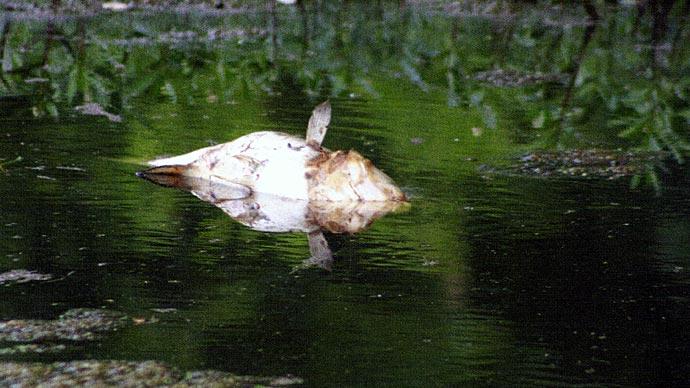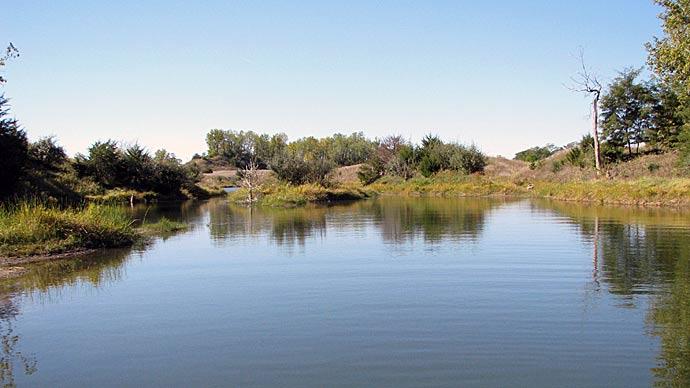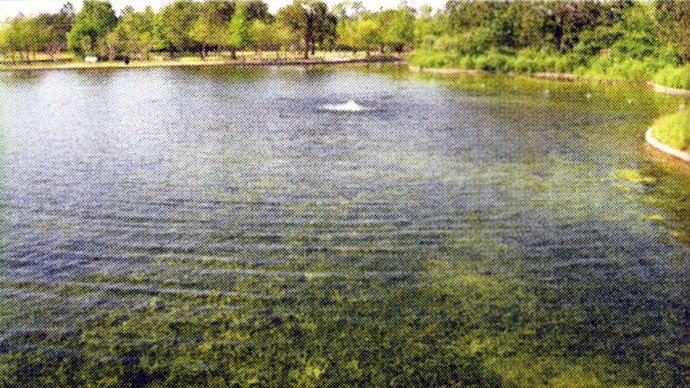
Fish do not have nine lives. One of my college fisheries professors spoke that wise little ditty in an aquaculture class years ago. It stuck in my brain and I often repeat it to students and pond owners. What it means is essentially this: conditions in your lake only have to be bad for less than one hour of one day during a fish's lifespan to kill them. Your lake environment may be suitable one day, then bad the next. When you see dead fish, it's too late. In my experience, fish can die quickly and often unexpectedly.
In the aquaculture business, a famous quote is, "You aren't a fish farmer until you have killed some fish."
Fish only die once.
What can you do to avoid that deadly hour? Pay attention to water quality. Water may tell you when things are going south. Here's a brief water quality primer with key terms and a few monitoring tips.
Let's get some scientific stuff out of the way. You've heard the adage that water is the "universal solvent." Many things dissolve in water, including gasses and minerals. When something dissolves in water, like table salt, components of the substance ionize. Salt ionizes into its constituents, sodium and chloride. Concentrations of dissolved substances are usually measured in parts per thousand, parts per million (most common water quality measurements), milligrams per liter (mg/L) or parts per billion (heavy metals, contaminants and phosphorus). So. one part per million (ppm) is exactly what is sounds like, one part of something in one million parts of water. A milligram per liter is one milligram of something dissolved in I(XX) milliliters of water (1L). Therefore, one milligram per liter is exactly the same as one part per million and one microgram per liter (ug/L) is the same as one part per billion. This is all possible because one liter of water weighs one kilogram. Yikes! No! Not the metric system! Anything but that!
What about pH? Trust me, you do not want the textbook definition of pH. All you need to know is that pH is a measure of how acidic or basic the water is. The pH scale goes from 0-14, where 7 is neutral. If your pH is less than 7 the water is acidic and if greater than 7 the water is basic. Battery acid has a pH of 0, vinegar has a pH of 2, distilled water has a pH of 7 (neutral), soapy water has a pH of 12 and drain cleaner a pH around 14. Optimal pH for most fish is 6.5 to 8.5. Brief exposure to higher and lower pH is often not a huge problem. Brook trout like water slightly acidic and tilapia like water more basic, often thriving in water with a pH of 8.5 or higher. Simply speaking, a pH of 6 is 10 times more acidic than a pH of 7. A pH of 5 is 10 times more acidic than a pH of 6. And so on.
Alkalinity is a measurement of the ability of water to resist changes in pH. In fancy speak: it is a measure of carbonate and bicarbonate ions. Throw some baking soda (sodium bicarbonate) in water and you will increase alkalinity. Alkalinity is simply Nature's Rolaids. Fish do best in water that has 1(X)-4(X) mg/l total alkalinity. Levels below 50 mg/l can result in rapid pH fluctuations, which is not good for most fish. We learn this lesson in spades here in upstate New York. Acid rain falls in our Adirondack Mountains where bedrock is granite. Soil derived from granite bedrock has low alkalinity, resulting in poorly buffered lakes. Lakes acidify, often driving the pH down into the 4's. Not good! Fish die.
It is important to note alkalinity and pH are linked and plant photosynthetic activity influences pH during the course of a day. During photosynthesis, plants remove carbon dioxide and produce oxygen. Removal of carbon dioxide causes carbonate ions to accumulate (don't worry about how), raising pH of the water. In poorly buffered waters, pH can reach 9-10 during intense photosynthesis. During dark hours the opposite happens (respiration), causing pH in a poorly buffered pond to drop down to 4-5. Ouch! Here's the "take home message": you want a pond that has good buffering ability (moderate alkalinity) to avoid huge daily pH swings.
Next up. Hardness. Hardness is a measure of magnesium and calcium ions in pond water. Aquatic life needs these metals to make their exoskeleton, bones and to simply grow. What would happen to you if you didn't take in some calcium? Got milk? Optimal hardness is 1(K)-4(X) mg/l. 50-1(X) mg/1 is marginal, and levels below 50 mg/l are a problem. Now, what about "hard" and "soft" water? For biological purposes water less that 40-50 mg/l is "soft" and water over is "hard" (Boyd. 1990). We hear misconceptions about "hard" water from the water purification industry, where "hard" water (mostly iron and calcium in drinking water) is had and "soft" is good. Hard water leaves stains in our showers and clothes and soap works none too good in this "hard" water. In your pond, think opposite. Hard waters are generally phosphorus, generally increase proportionately with hardness.
Phosphorus is generally considered the most limiting nutrient regulating primary pond productivity. Rooted plants, plankton and planktonic algae respond to phosphorus. The rest of the food chain usually follows the primary production from these plants. In production ponds, fish growers often add a fertilizer rich in phosphorus to stimulate the food chain. In natural lakes, phosphorus concentrations may be low, despite green water, because it may be locked up in plant growth. Most natural waters have phosphorous concentrations ranging from 5-100 micrograms per liter (jag/1), although 5-25 ug/1 is the range I have most regularly encountered. Treated sewage effluent can be in the neighborhood of 1000-3000 ug/1. Phosphorus is routinely measured in micrograms (a one-millionth of a gram) per liter.
Dissolved oxygen (DO) is required for metabolism by fish and most other aquatic organisms. Cold water holds more oxygen, warm water holds less. See the graph in the last Pond Boss. Altitude also has an effect on how much oxygen water can hold. As altitude increases, amounts of dissolved oxygen decreases. At the same temperature, fresh water at sea level will hold more dissolved oxygen than water at l(KK)ft above sea level. Think of it as an air pressure thing. There is more atmosphere pushing down from above the LOWER you are on the Earth. This atmospheric pressure is what holds oxygen in water. Most warm water fish struggle when dissolved oxygen falls below 5 ppm. Rough fish as carp and bullhead tolerate lower DO's and finicky fish like trout die easily if DO dips below 5 ppm. Small fish recover more quickly from a low DO event than do large ones. DO absorbs into pond water by diffusion from the atmosphere or by additions from photosynthesis by plants.
What about temperature? Different groups of fish prefer different temperatures. What a revelation! Generally, optimum temperatures are 55-60F for cold-water fish. 65-70F for cool-water fish, 75-80F for warm water fish and 85-90F for tropical fish.
If you feed heavily or have a fertile bait production pond it is possible to have a problem with ammonia. Ammonia results from the break down of proteins and is more toxic to fish at high pH and high temperatures. Ammonia is a waste product of fish. Total ammonia becomes a problem around 1 ppm. Since ammonia is heavier than water, it usually exists with low or no dissolved oxygen conditions near the bottom. In ponds, ammonia can be used directly by plants or changed into nitrite and then nitrate by bacteria. In fisheries terms, this is called "denitrification."
Nitrite is an intermediate product of biofiltration (by bacteria) and is highly toxic to fish, but nitrate is not. Ponds rarely have a problem with nitrite unless they are heavily fed. So, you pondmeisters who push the envelope of fish production by overfeeding run an increased risk of dealing with high levels of nitrogen. The end product of biofiltration is nitrate..which plants utilize. Nitrite bad. Nitrate good.
Conductivity is of interest if you want to keep productivity high. Conductivity is a measure of how well electricity is conducted, which is dependent on levels of dissolved ions (like salts and other solids) in the water. Total dissolved solids (TDS) is another way to express conductivity. Conductivity is a crude measure of nutrient levels in water. Optimal conductivity 4 ranges from 1(X)-3(X) umhos.
So how does one measure all these things? If you are really serious about doing it yourself, the simplest thing to do is buy a fish farmer water testing kit from a company called HACH (www.hach.com). I would recommend the model FF1-A, which is the kit that we hand out to our aquaculture students. It will test temperature, dissolved oxygen, hardness. pH, alkalinity, ammonia, carbon dioxide, nitrite and a number of other parameters that we have not discussed here. These kits cost about $240. Several Pond Boss advertisers sell these kits. Another, more expensive option is a water meter. A good, reliable meter is a YSI 556MPS meter which will measure temperature, DO, pH. conductivity, salinity, total dissolved solids and a few other parameters. Problem with these meters is that you have to calibrate them regularly lo make sure they are accurate, which means making up standard solutions and spending some serious time understanding how the thing works. They run about $2.500 and are available at www.ysi.com. If all this scares you...hire a professional or send a sample to a quality lab. You can have someone come to the pond or you can send your water to a good lab service. They will send results back to you, most of the time with interpretations and recommendations. However, this solution does you no good if you have a fish emergency and need to quickly find out why your fish are stressed. Send out lab services are not good for dissolved gases (like oxygen) unless the samples are specially prepared because gas concentrations change during collection and shipment.
Most fish kills in ponds I have investigated result from oxygen depletion or temperature kills. In the North, we have fish kills associated with winterkill and summer kill. Winterkills result from a couple of problems coming together at once. Ice forms on the pond and essentially caps it from interacting with the atmosphere. Oxygen entering the water from atmospheric diffusion is stopped. Snow accumulates on the ice and essentially draws a shade over the pond, which reduces or eliminates photosynthesis. Once the shade is pulled (by snow on the ice) respiration exceeds photosynthesis and existing DO in the pond is what aquatic life has until ice off. Think of Dorothy and the hour glass turned over by the wicked witch of the West. Take a winter's worth of deep snow on ice and add to it a productive, fertilized or shallow pond and you have big trouble. Will drilling holes in the ice help? Yes. if you want to work up a sweat and get out of the house. No, if you are out to save the fish. The pond is inversely stratified in winter, where the warmest, most dense water is on the bottom (that's why ice floats!). This water will not circulate to the top with a few modest holes. Solution? Shovel or plow snow off to let in the sun! This will allow the photosynthetic (plant) pathway to start again and add oxygen to the pond. You can also aerate the pond but do so carefully, in shallow water. Don't aerate deep. You do not want to chill pond water too much by circulating all water upward to an extremely cold atmosphere. Before walking or driving on the ice see Dr. Willis' article in the last issue of Pond Boss please!
In summer kill, super productive ponds usually go through oxygen spikes and depressions. DO is high after peak sunlight at 5-6 pm in summer and lowest at 5-6 am, just before sunrise, after longest period of respiration without photosynthesis. This early morning scenario is when a productive pond is most likely to die...just before sun-up, particularly if the previous day was cloudy and still. If you have trout in your pond, deep summer is also a time for concern. Production from pond upper layers falls to the bottom and decomposes, using oxygen from the bottom up. This forces fish from cool bottom waters into an overlying upper layer that may have enough DO but is likely too warm. As summer wears on, the problem worsens and your cold water fish may perish. Not good either! Summer time aeration may help but may also de-stratify your pond. De-stratification may be good for warm water fish, but is most likely a death sentence to cold water critters.
Prevention? Don't overfertilize. Choose the right fish for the pond. Don't stock trout unless you know you have adequate, well oxygenated and healthy water in your pond. Rule of thumb for trout here in New York is 1/3 of the volume of the pond should be over 10 feet deep or you need a good cold spring. Can I add well water to cool down the pond? Maybe, but be careful. Well water has no oxygen. You need to aerate it before sending it to the deep areas of the pond. Don't waste well water by dumping it in somewhere shallow where its chilling effect will be lost.
Go and have some fun with the water quality in your pond. After all you only live once...
Mark Cornwell is a fisheries professor at SUNY-Cobleskill in Cohleskill, New York. His passion is raising walleye and the I.Q. of fisheries students in the Northeast.
Reprinted with permission from Pond Boss Magazine



